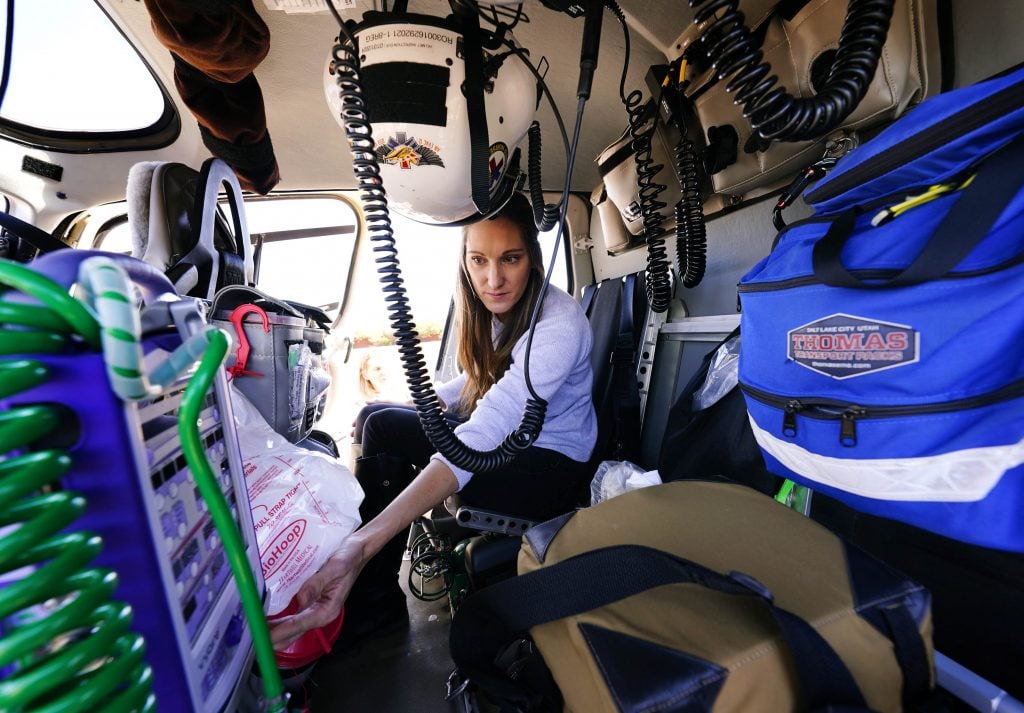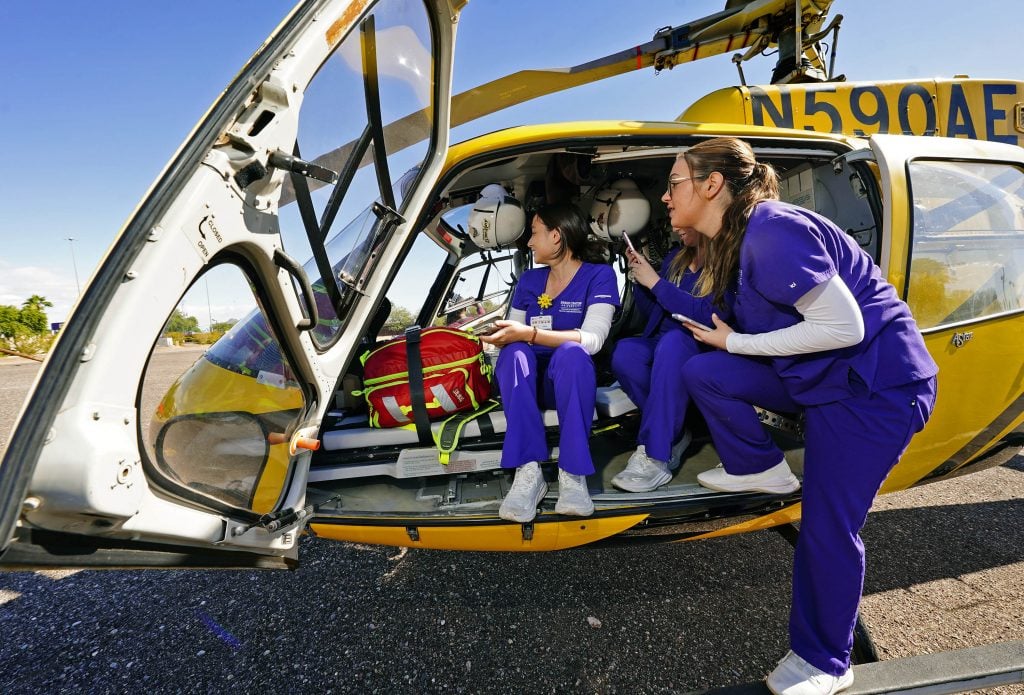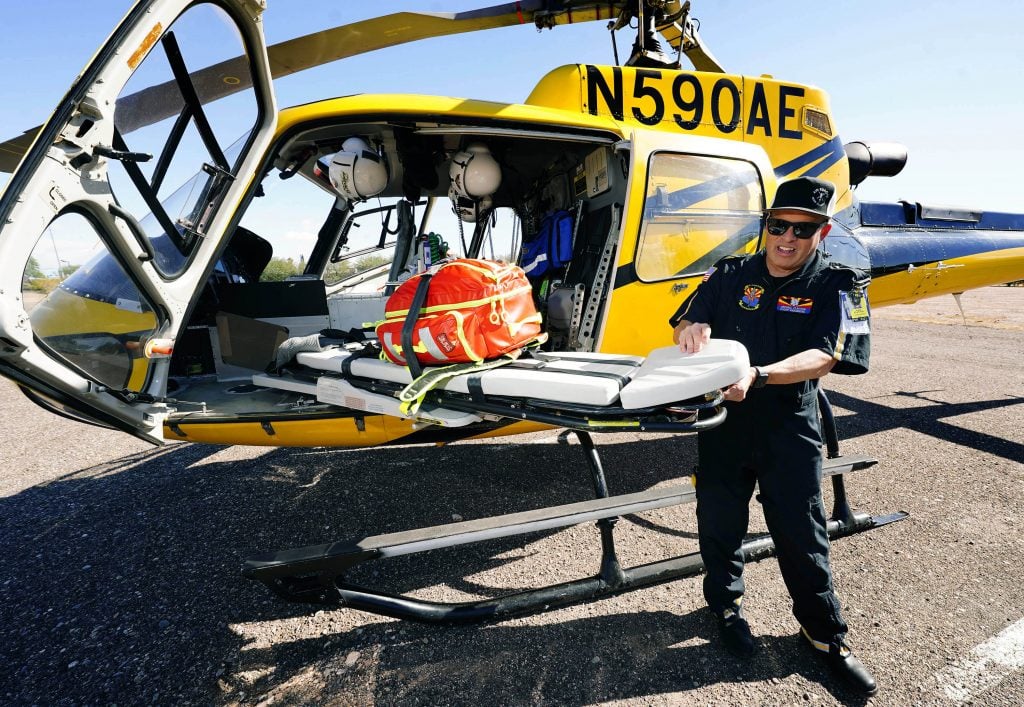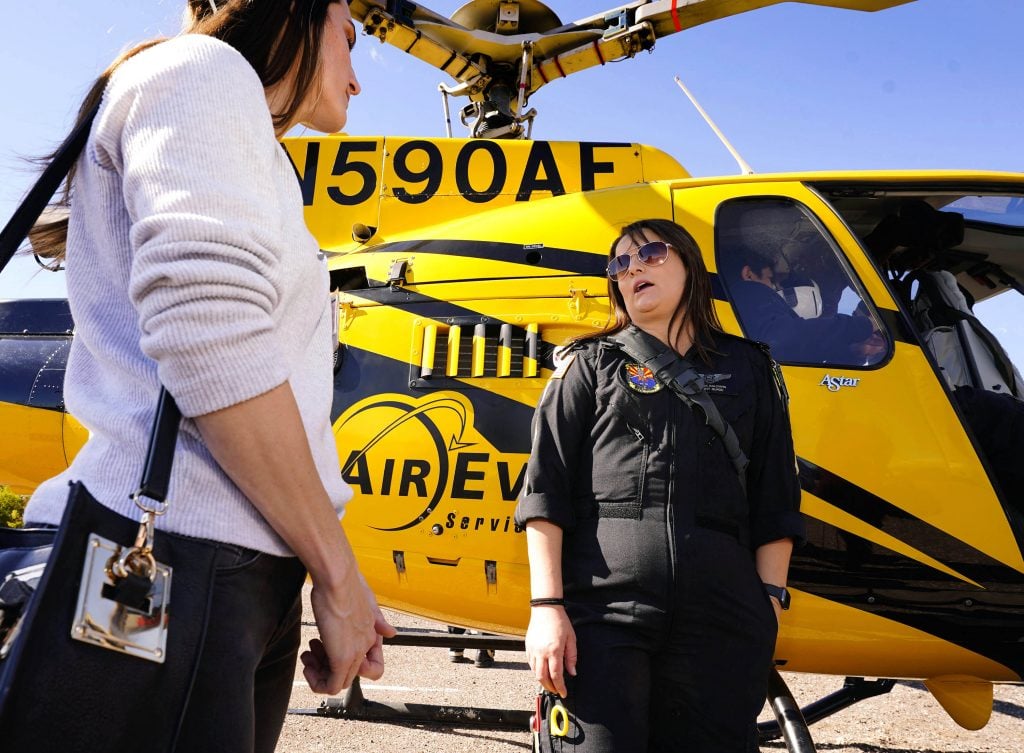
Photos by Ralph Freso / Slideshow
Lindsey Di Conti was a camp counselor when she first saw a flight nurse in action.
A camper went into anaphylactic shock after a bug bite, and an air medical evacuation team airlifted the camper out of the remote area.
That flight nurse? A rock star.
“It was really cool to see them come save our little kid when we were out in the middle of nowhere,” said Di Conti, a third-semester nursing student at Grand Canyon University’s West Valley Accelerated Bachelor of Science in Nursing site.
Back then, she didn’t even know she wanted to be a nurse, and after she started nursing school, she knew she didn’t want to do anything related to emergency or trauma care.

“But I found that I really like the adrenaline and the fast pace,” said Di Conti, who wants to work in an emergency room and is thinking of transitioning into flight nursing, where she would have more independence and "do a lot of procedures you can't do as an RN."
So she was thrilled on Thursday to head to the parking lot south of GCU Hotel, adjacent to her ABSN site, where she got to explore a medical air helicopter and speak to an experienced flight nurse and flight paramedic.
The site’s manager, Charlotte Mitchell, organized the visit with PHI Air Medical for West Valley ABSN students.
“We have a lot of students interested in being flight nurses, and so we wanted to give them the experience to see inside and actually look inside (a medical air helicopter) and get a hands-on experience,” Mitchell said. “They’re on their lunch breaks right now and taking time between exams to be here.”
“It’s a total blast (being a flight paramedic),” said Mike Clayton, who serves with PHI Air Medical’s AE-12 Deer Valley team and has worked in emergency medical services and fire departments for more than three decades. “It’s something different every day. It’s highly unpredictable.”
Just like in his fire department days, he works 24-hour shifts. The flight crew has their own sleeping quarters, recliners and, in between medical emergencies, their time is their own.
“We may have to study, there may be online classes we have to do,” he said.
But that calm shifts quickly when the team – usually a flight paramedic, flight nurse and helicopter pilot – gets a call.
Once the fire department requests a helicopter emergency medical services crew, they’re up in the air within five to six minutes, and once there, “our goal is about five minutes on scene,” said Clayton, who also spoke about the helicopter that transports the medical flight team to the scene.

Everything in a trauma bay is on the helicopter, from a ventilator to monitors to blood products and equipment that allows the team to do chest tubes, sedations and intubations.
“And we carry drugs on our helicopter that ground EMS doesn’t carry,” he said.
Reaching the level of a flight nurse or paramedic isn’t easy, stressed flight nurse Amelia Baldwin in her talk to students.
“If you want to do it – it’s a great thing to do – but it does take a little bit of time. I’ve been doing this about two years, and it’s taken me quite some time to get the experience that I needed to do it,” said Baldwin, who worked as a paramedic before becoming a nurse and has experience in trauma, the emergency room and the intensive care unit.
Baldwin said air medical teams want to see aspiring flight nurses’ experience in critical care “and any other certifications you can get,” she said.
Once you do get that experience, you then get additional training for the job.
“It’s a rigorous academy,” Clayton said of the 90-day training flight nurses and paramedics go through.
Baldwin said, “They definitely want to see that you know how to handle a critical patient, because the one difference in flying vs. working in a hospital is that you do not have a doctor telling you what to do. You’re expected to use your critical thinking skills. … You’re making these quick calls and these quick decisions. What drugs am I going to use to intubate? And (they want to see you) being proficient with your times in getting these done.”
Baldwin said her team has been able to complete rapid sequence intubations in the field and has gotten a patient into the air and on their way in 20 minutes.
“Again, we work together and become fluid, and we train all the time … we’re always studying, we’re always practicing.”
Added Clayton, “I spend more time with my (flight) partner sometimes than with my family. We don’t even need to talk a lot of times when you work with somebody enough.”
The reason they are so efficient is that the team is preparing ahead of time: “You’re always a step ahead,” Clayton said. “ … If we’re getting launched to a high stress call, I make a point to get my ducks in a row.”

He uses a phone app to look up pediatric doses of medicine, for example.
Baldwin said, “We’re very methodical in where we put our drips and our lines so we have easy access to the patient. There’s a method to what we do so that if something were to happen, we can address it very quickly. We have all of our drugs, basically sitting on my lap and I am ready with everything he might need to push it on a patient.”
Once on scene, they always strive to maintain their calm even though they might not feel calm inside.
“When I get there, it’s usually a high-stress call with kids," Clayton said. "Everybody’s freaking out, the family’s crying, the fire department is all shook up. We’ve got to get in there, lower the stress level, so we delegate jobs for everybody to do – ‘Hey, can you get me a blood pressure?’ ‘Can you set up an IV for me?’ – and you just kind of take a slow, deep breath. I gather my thoughts, and even though I may be scared inside, (I have to remember) your attitude is contagious.”
One student at the West Valley ABSN site asked about the downsides of the job.
The stress level is high, Clayton said. “You deal with drownings and kids getting ejected out of the car, and you see a lot of horrible stuff, every shift.”
Another negative, he said, is you miss out on time with family, “like my daughter getting pinned for Girl Scouts.”
He advised students in this field to have an outlet. It's hard for family members who aren’t in the same field to really relate to your day, he added, “so you need to depend on your coworkers if you need help, like if you’re having mental health issues, depression. It’s important to talk about it.”
Despite the downsides, Clayton said, it's work that fulfills him. “This is what I LOVE to do.”
Manager of Internal Communications Lana Sweeten-Shults can be reached at [email protected] or 602-639-7901.
***
Related content:
GCU News: Student taking a second shot, this time as a nurse
GCU News: Nurse who makes the move to the U.S. finds passion in teaching
GCU News: GCU expands accelerated nursing program to St. Louis




